Page 283 of 409
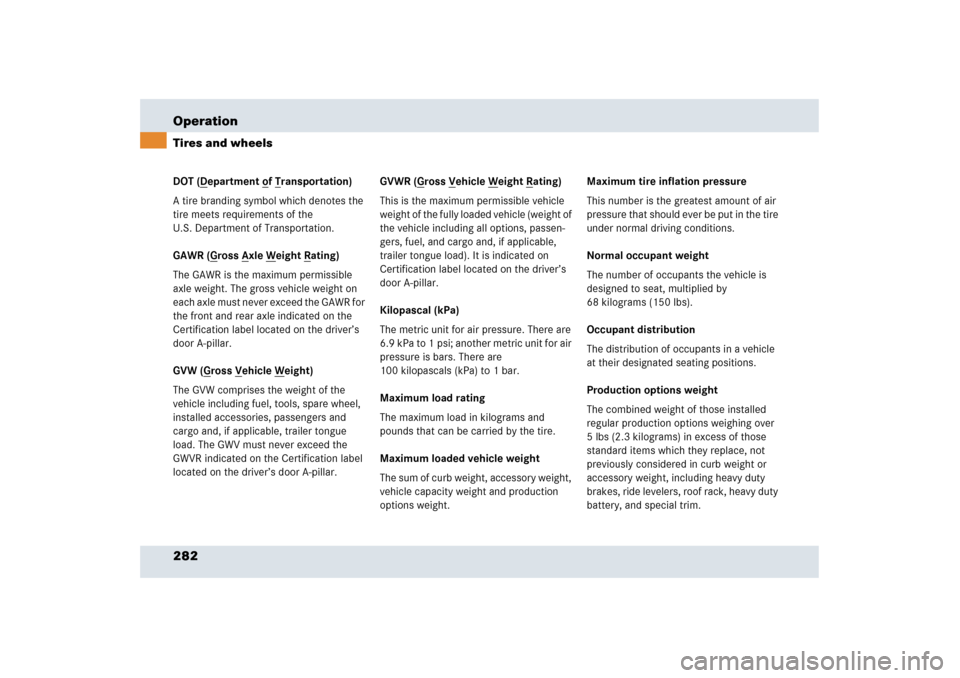
282 OperationTires and wheelsDOT (D
epartment o
f T
ransportation)
A tire branding symbol which denotes the
tire meets requirements of the
U.S. Department of Transportation.
GAWR (G
ross A
xle W
eight R
ating)
The GAWR is the maximum permissible
axle weight. The gross vehicle weight on
each axle must never exceed the GAWR for
the front and rear axle indicated on the
Certification label located on the driver’s
door A-pillar.
GVW (G
ross V
ehicle W
eight)
The GVW comprises the weight of the
vehicle including fuel, tools, spare wheel,
installed accessories, passengers and
cargo and, if applicable, trailer tongue
load. The GWV must never exceed the
GWVR indicated on the Certification label
located on the driver’s door A-pillar.GVWR (G
ross V
ehicle W
eight R
ating)
This is the maximum permissible vehicle
weight of the fully loaded vehicle (weight of
the vehicle including all options, passen-
gers, fuel, and cargo and, if applicable,
trailer tongue load). It is indicated on
Certification label located on the driver’s
door A-pillar.
Kilopascal (kPa)
The metric unit for air pressure. There are
6.9 kPa to 1 psi; another metric unit for air
pressure is bars. There are
100 kilopascals (kPa) to 1 bar.
Maximum load rating
The maximum load in kilograms and
pounds that can be carried by the tire.
Maximum loaded vehicle weight
The sum of curb weight, accessory weight,
vehicle capacity weight and production
options weight.Maximum tire inflation pressure
This number is the greatest amount of air
pressure that should ever be put in the tire
under normal driving conditions.
Normal occupant weight
The number of occupants the vehicle is
designed to seat, multiplied by
68 kilograms (150 lbs).
Occupant distribution
The distribution of occupants in a vehicle
at their designated seating positions.
Production options weight
The combined weight of those installed
regular production options weighing over
5 lbs (2.3 kilograms) in excess of those
standard items which they replace, not
previously considered in curb weight or
accessory weight, including heavy duty
brakes, ride levelers, roof rack, heavy duty
battery, and special trim.
Page 284 of 409
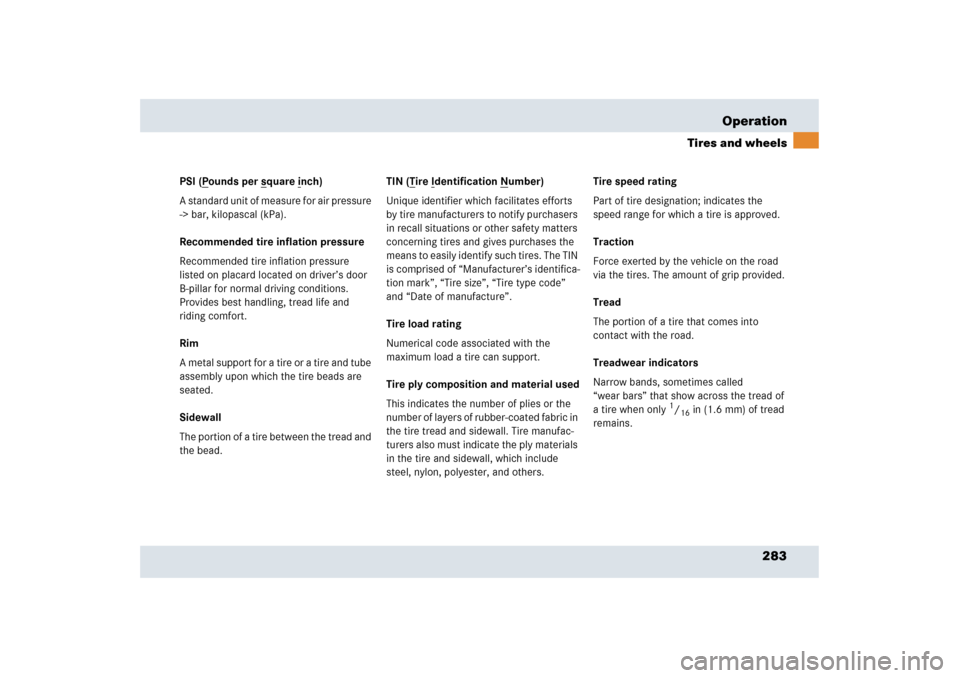
283 Operation
Tires and wheels
PSI (P
ounds per s
quare i
nch)
A standard unit of measure for air pressure
-> bar, kilopascal (kPa).
Recommended tire inflation pressure
Recommended tire inflation pressure
listed on placard located on driver’s door
B-pillar for normal driving conditions.
Provides best handling, tread life and
riding comfort.
Rim
A metal support for a tire or a tire and tube
assembly upon which the tire beads are
seated.
Sidewall
The portion of a tire between the tread and
the bead.TIN (T
ire I
dentification N
umber)
Unique identifier which facilitates efforts
by tire manufacturers to notify purchasers
in recall situations or other safety matters
concerning tires and gives purchases the
means to easily identify such tires. The TIN
is comprised of “Manufacturer’s identifica-
tion mark”, “Tire size”, “Tire type code”
and “Date of manufacture”.
Tire load rating
Numerical code associated with the
maximum load a tire can support.
Tire ply composition and material used
This indicates the number of plies or the
number of layers of rubber-coated fabric in
the tire tread and sidewall. Tire manufac-
turers also must indicate the ply materials
in the tire and sidewall, which include
steel, nylon, polyester, and others.Tire speed rating
Part of tire designation; indicates the
speed range for which a tire is approved.
Traction
Force exerted by the vehicle on the road
via the tires. The amount of grip provided.
Tread
The portion of a tire that comes into
contact with the road.
Treadwear indicators
Narrow bands, sometimes called
“wear bars” that show across the tread of
a tire when only
1/16
in (1.6 mm) of tread
remains.
Page 286 of 409
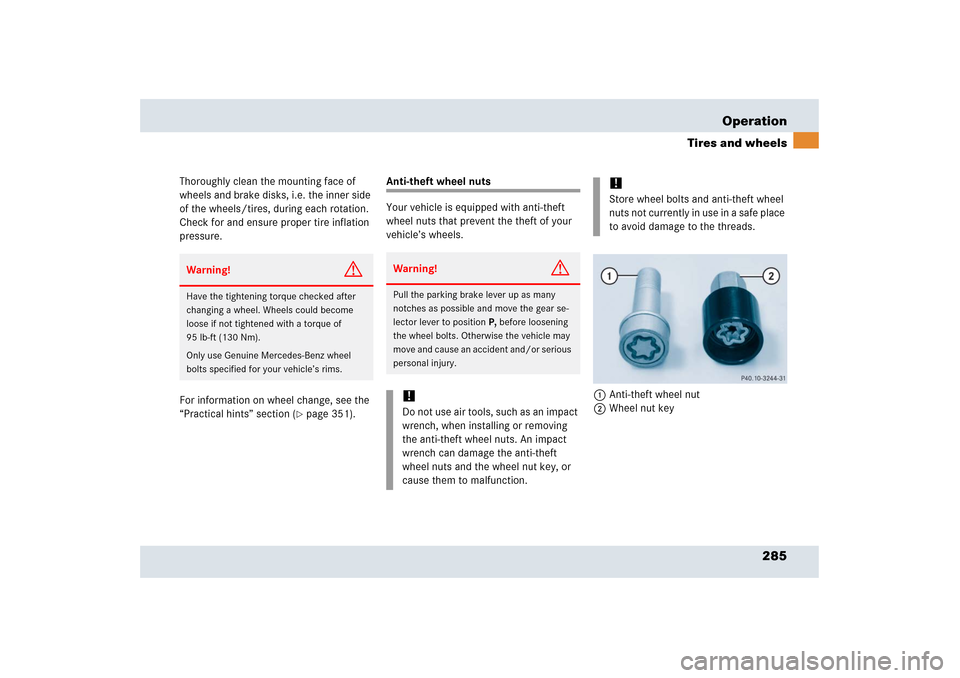
285 Operation
Tires and wheels
Thoroughly clean the mounting face of
wheels and brake disks, i.e. the inner side
of the wheels/tires, during each rotation.
Check for and ensure proper tire inflation
pressure.
For information on wheel change, see the
“Practical hints” section (
�page 351).
Anti-theft wheel nuts
Your vehicle is equipped with anti-theft
wheel nuts that prevent the theft of your
vehicle’s wheels.
1Anti-theft wheel nut
2Wheel nut key
Warning!
G
Have the tightening torque checked after
changing a wheel. Wheels could become
loose if not tightened with a torque of
95 lb-ft (130 Nm).
Only use Genuine Mercedes-Benz wheel
bolts specified for your vehicle’s rims.
Warning!
G
Pull the parking brake lever up as many
notches as possible and move the gear se-
lector lever to positionP, before loosening
the wheel bolts. Otherwise the vehicle may
move and cause an accident and/or serious
personal injury. !Do not use air tools, such as an impact
wrench, when installing or removing
the anti-theft wheel nuts. An impact
wrench can damage the anti-theft
wheel nuts and the wheel nut key, or
cause them to malfunction.
!Store wheel bolts and anti-theft wheel
nuts not currently in use in a safe place
to avoid damage to the threads.
Page 297 of 409
Practical hintsWhat to do if ...
Where will I find ...?
Unlocking in an emergency
Replacing SmartKey batteries
Replacing bulbs
Replacing the wiper blades
Flat tire
Batteries
Towing the vehicle
Fuses
Page 306 of 409
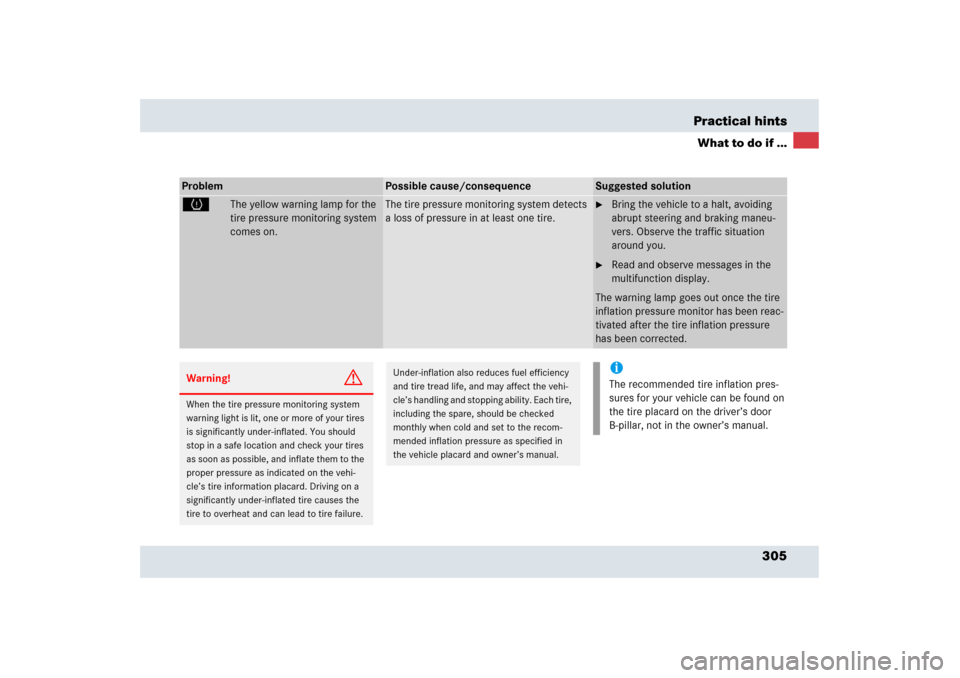
305 Practical hints
What to do if ...
Problem
Possible cause/consequence
Suggested solution
H
The yellow warning lamp for the
tire pressure monitoring system
comes on.
The tire pressure monitoring system detects
a loss of pressure in at least one tire.
�
Bring the vehicle to a halt, avoiding
abrupt steering and braking maneu-
vers. Observe the traffic situation
around you.
�
Read and observe messages in the
multifunction display.
The warning lamp goes out once the tire
inflation pressure monitor has been reac-
tivated after the tire inflation pressure
has been corrected.
Warning!
G
When the tire pressure monitoring system
warning light is lit, one or more of your tires
is significantly under-inflated. You should
stop in a safe location and check your tires
as soon as possible, and inflate them to the
proper pressure as indicated on the vehi-
cle’s tire information placard. Driving on a
significantly under-inflated tire causes the
tire to overheat and can lead to tire failure.
Under-inflation also reduces fuel efficiency
and tire tread life, and may affect the vehi-
cle’s handling and stopping ability. Each tire,
including the spare, should be checked
monthly when cold and set to the recom-
mended inflation pressure as specified in
the vehicle placard and owner’s manual.
iThe recommended tire inflation pres-
sures for your vehicle can be found on
the tire placard on the driver’s door
B-pillar, not in the owner’s manual.
Page 314 of 409

313 Practical hints
What to do if ...
Left display
Right display
Possible cause/consequence
Possible solution
Tire pres. monitor
reactivated
The tire pressure monitoring system is using
the current pressure values as the basis for
monitoring.
Tire pressure
displayed only
when ignition
is on
The tire inflation pressure is being checked.
�
Switch on the ignition (
�page 40).
Tire pres.
monitor
temporarily
unavailable
The tire inflation pressure monitor is unable
to monitor the tire inflation pressure due to�
the presence of several wheel sensors in
the vehicle.
�
excessive wheel sensor temperatures.
�
a nearby radio interference source.
�
unrecognized wheel sensors mounted.
�
Remove any extra wheel sensors
from the vehicle.
As soon as the causes of the malfunc-
tion have been removed, the tire pres-
sure monitoring system automatically
becomes active again.
Warning!
G
Do not drive with a flat tire. A flat tire affects
the ability to steer or brake the vehicle.
You may lose control of the vehicle. Contin-
ued driving with a flat tire will cause exces-
sive heat build-up and possibly a fire.
Page 315 of 409

314 Practical hintsWhat to do if ...Left display
Right display
Possible cause/consequence
Possible solution
Reactivate tire
pressure monitor
after rectifying
pressure
There was a tire inflation pressure warning
message.
The yellow warning lamp for the tire pres-
sure monitoring system comes on and you
have not reactivated the system since the
last tire inflation pressure warning message.
�
Reactivate the tire pressure monitor-
ing system after correcting the tire
inflation pressure values
(�page 269).
Tire pres.
monitor inoperative
Drive to workshop
The tire inflation pressure monitor is mal-
functioning.
�
Have the tire inflation pressure
monitor checked by an authorized
Mercedes-Benz Center.
A wheel without proper sensor was
installed.
�
Have the wheel checked.
Tire pressure
Please rectify
The tire inflation pressure is too low in one
or more tires.
�
Check and correct tire inflation pres-
sure as required (
�page 266).
Warning!
G
Do not drive with a flat tire. A flat tire affects
the ability to steer or brake the vehicle.
You may lose control of the vehicle. Contin-
ued driving with a flat tire will cause exces-
sive heat build-up and possibly a fire.
Page 336 of 409
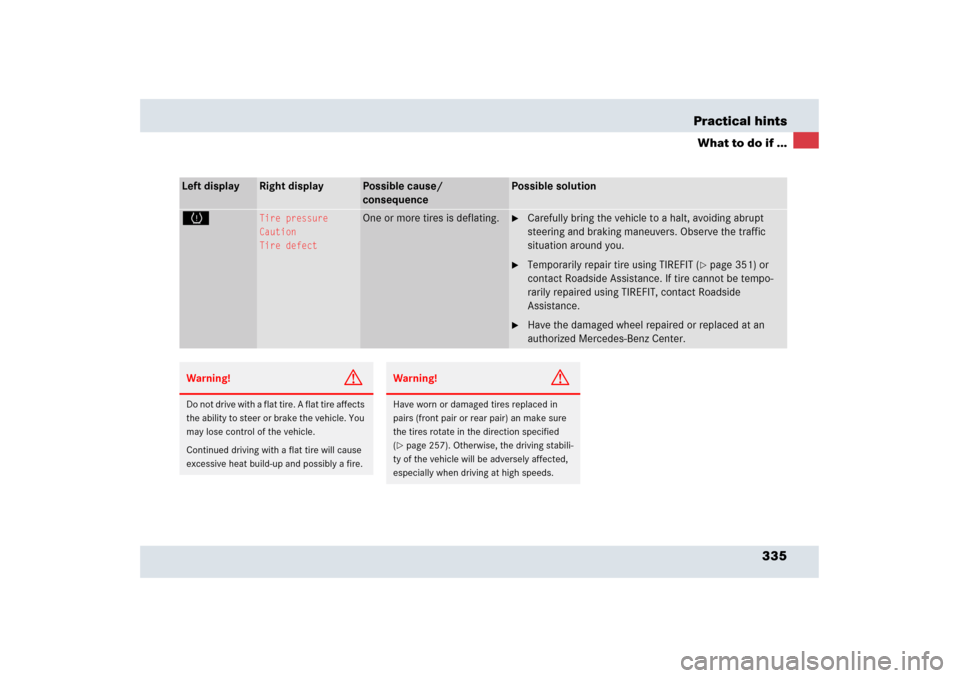
335 Practical hints
What to do if ...
Left display
Right display
Possible cause/
consequence
Possible solution
H
Tire pressure
Caution
Tire defect
One or more tires is deflating.
�
Carefully bring the vehicle to a halt, avoiding abrupt
steering and braking maneuvers. Observe the traffic
situation around you.
�
Temporarily repair tire using TIREFIT (
�page 351) or
contact Roadside Assistance. If tire cannot be tempo-
rarily repaired using TIREFIT, contact Roadside
Assistance.
�
Have the damaged wheel repaired or replaced at an
authorized Mercedes-Benz Center.
Warning!
G
Do not drive with a flat tire. A flat tire affects
the ability to steer or brake the vehicle. You
may lose control of the vehicle.
Continued driving with a flat tire will cause
excessive heat build-up and possibly a fire.
Warning!
G
Have worn or damaged tires replaced in
pairs (front pair or rear pair) an make sure
the tires rotate in the direction specified
(�page 257). Otherwise, the driving stabili-
ty of the vehicle will be adversely affected,
especially when driving at high speeds.